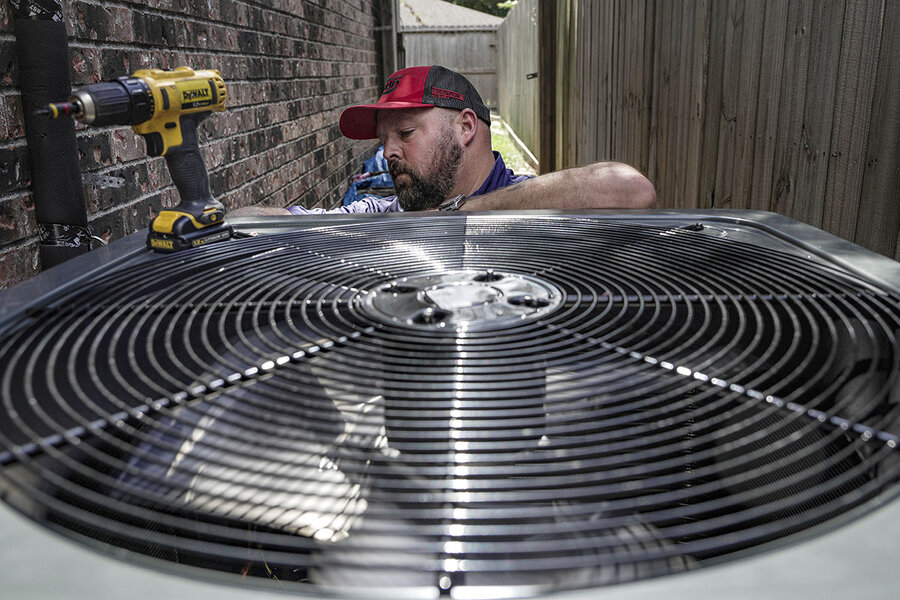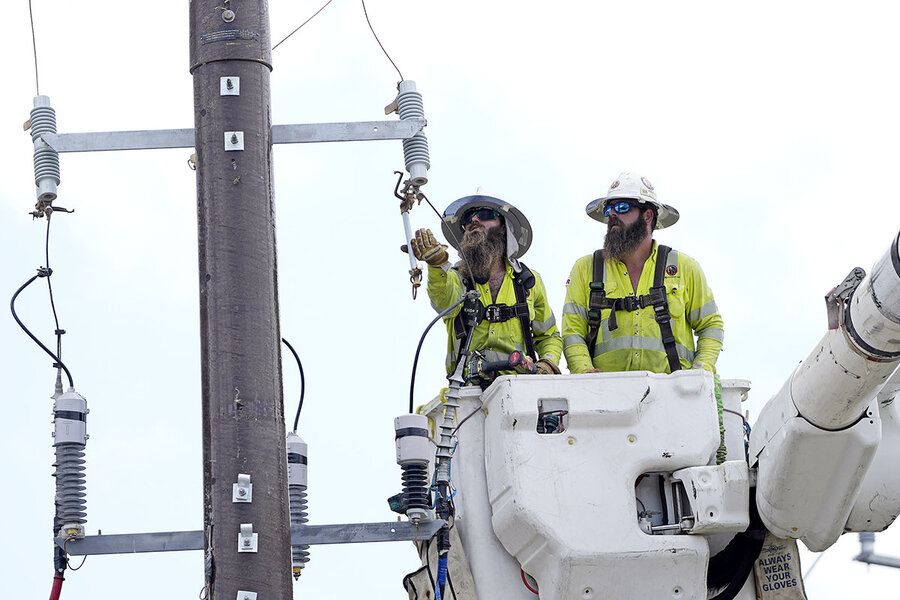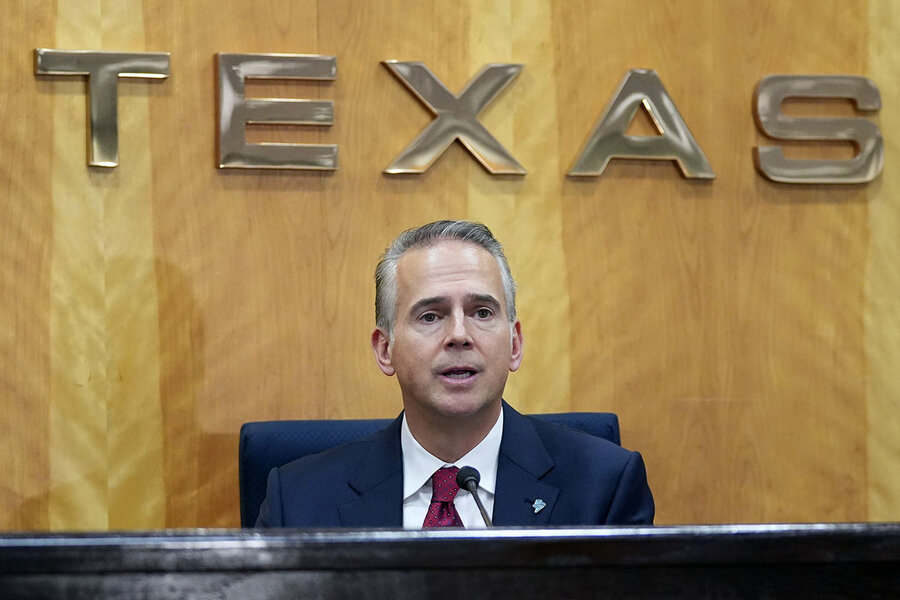Amid record heat wave, Texas grid powers through
Loading...
| AUSTIN, Texas
In the crucible of a blazing summer, Texas is forging a reputation as a clean energy leader.
As each new week seems to bring a new record for electricity demand, the Texas power grid has held firm. Lights have stayed on and air conditioning has kept running, thanks in part to a significant increase in clean energy hooked up to the the Electric Reliability Council of Texas’ grid.
Why We Wrote This
A story focused onThe Texas power grid – famous for failing when it is most needed – has come through weeks of record 100-degree days like a champ. Its performance could provide a model for the rest of the United States on what energy transformation can look like.
No state produces more wind power, and solar capacity has been doubling year over year. Battery storage – critical to buttressing intermittent renewables like wind and solar – is poised for a similar boom. This transformation has occurred despite broad antipathy, and at times hostility, from the state’s mostly Republican lawmakers. How the state weathers this summer of extremes may be educational as power grids around the country seek to decarbonize.
“The energy transition is here, and Texas is among the states that are leading the way,” says Ryan Wiser, a senior scientist at the Lawrence Berkeley National Laboratory.
With an extreme heat wave gripping half the country, this summer has been less one to enjoy than one to endure.
Temperatures averaging above 100 degrees Fahrenheit during the day and in the 90s at night have kept Americans in the Southern and Western United States sheltering inside whenever they can, as the country’s aging electrical grid works overtime to support air conditioners fighting Saharan heat. And for Texas, prolonged heat waves in June and then July had the potential for widespread disruption, if not disaster.
Unlike the rest of the country, which is part of a network of interconnected power grid systems, most Texans live on an isolated grid. That grid, operated by the Electric Reliability Council of Texas (ERCOT), is also supporting a growing number of people and facing a growing frequency of extreme weather events. If that grid fails, the state goes dark – as it did with tragic consequences during a winter storm in 2021.
Why We Wrote This
A story focused onThe Texas power grid – famous for failing when it is most needed – has come through weeks of record 100-degree days like a champ. Its performance could provide a model for the rest of the United States on what energy transformation can look like.
But in the crucible of a blazing summer, Texas is forging a reputation as a clean energy leader.
As each new week seems to bring a new record for electricity demand, the Texas power grid has held firm. Lights have stayed on and air conditioning has kept running, thanks in part to a significant increase in clean energy hooked up to the ERCOT grid.
No state produces more wind power, and solar capacity has been doubling year over year. Battery storage – critical to buttressing intermittent renewables like wind and solar – is poised for a similar boom. This transformation has occurred despite broad antipathy, and at times hostility, from the state’s mostly Republican lawmakers. How the state weathers this summer of extremes may be educational as power grids around the country seek to decarbonize.
“The energy transition is here, and Texas is among the states that are leading the way,” says Ryan Wiser, a senior scientist at the Lawrence Berkeley National Laboratory.
The Energy State
Modern Texas has been built on fossil fuels. Since the Spindletop gusher in 1901, Texas has led the U.S. in oil and gas production. The U.S., in turn, has been among the top oil and gas producers in the world.
Natural gas continues to meet the majority of electricity demand in Texas, but in the past decade or two, renewable energy has begun to rival it. The state has led the country in wind power for 15 years. It could soon take the top spot in solar power as well, having more than tripled its capacity between 2020 and 2022. Battery storage in the state is projected to grow rapidly in the next few years as well, according to Reuters.
The geography of the state – vast and windy plains, bright sunshine – the pricing mechanisms of the ERCOT market, and the business-friendly regulatory environment have all helped drive the Texas clean energy boom. The state installed more utility-scale wind, solar, and battery storage than any other last year, and accounted for one-third of the entire country’s new capacity, according to Dr. Wiser. Over the past decade Texas added more wind, solar, and battery storage than any other state, and twice as much as runner-up California.
“Not only do you have a state that is just generally friendly to development activities, but it also has the land to support those development activities,” says Dr. Wiser.
“It’s phenomenally windy and sunny,” he adds. And “it’s just an easier place to do business.”
This increased renewable energy capacity has been put to good use, particularly this summer. The ERCOT record for daily peak electricity demand has been broken six times in the last four weeks alone. (Last summer the same record was broken 11 times.) Over the past five years, renewables have saved the average Texas ratepayer $200 a year, according to a report from Joshua Rhodes, a research scientist at the University of Texas at Austin.
As dangerous heat waves become more common – Texas saw at least 279 heat-related deaths last year, according to a Texas Tribune analysis, and there have been at least 14 such deaths reported this year – grid reliability is critical to public safety in the summer. And amid the record-breaking demand, solar power and renewables in general have set their own records for supplying that need. So far this year, carbon-free energy has generated more power for ERCOT than natural gas, according to data from the operator.
“The same sun that drives that heat is driving that solar [output],” says Dr. Rhodes, who is also a founding partner of the energy analysis firm IdeaSmiths.
“So far this summer, wind and solar have really been hitting out of the park.”
An open field to innovate – for now
Geography isn’t the only reason clean energy has boomed in Texas. ERCOT’s laissez-faire approach to new projects, compared with other markets, has also made it easier for renewable energy facilities to get up and running in the state.
A problem for grid operators nationwide is how long it can take to upgrade infrastructure and add new power sources. The country needs more transmission lines, and bureaucratic hurdles are leaving new renewable energy projects to wait years on the so-called interconnection queue before they can connect to an electrical grid.
“In many parts of the U.S., [interconnection] is the single biggest obstacle to building new power” capacity, says Devin Hartman, director of energy and environmental policy at the R Street Institute, a center-right think tank in Washington.
The Texas grid hasn’t felt these issues as severely, however. ERCOT built new transmission lines as wind power started growing in the 2010s, and it’s been able to connect new projects faster than many other grids in the country, experts say.
Between 2000 and 2017, only two grid operators saw over 30% of proposed new projects reach commercial completion, according to a report from the Lawrence Berkeley National Laboratory. ERCOT was one of them. With battery storage projects making up about one-third of the grid’s queue last year, that speed of bringing projects online is expected to result in Texas becoming a national leader in energy storage.
“ERCOT is among the leaders in processing interconnection requests more rapidly than other markets across the nation,” says Dr. Wiser. “There are certainly some lessons to be learned there.”
Federal incentives and allocations – including an array of new programs worth billions of dollars contained in the Inflation Reduction Act – have helped drive clean energy investments around the country. But Texas is a rare case, in the sense that the renewable energy boom here has been unfolding with limited support from state lawmakers. In fact, hostility toward clean energy has been more common.
During the 2021 winter storm that claimed 246 lives and left millions without electricity for days, officials erroneously blamed wind power for the grid failures. And during the state legislative session this year, lawmakers tried – but failed – to pass bills that would have imposed onerous new regulations on renewable energy facilities and projects, according to the energy law firm Foley & Lardner.
As much as anything, it’s the political landscape in Texas that worries experts tracking the state’s power grid. Oil and gas have fueled a century of prosperity in the state, becoming central to its identity and culture.
“While it’s economically winning, there are these policy head winds that seem to be getting thrown up,” says Scott Hinson, chief technology officer at Pecan Street, an Austin-based clean energy research and development organization.
“I’m wondering at what point that is going to put the brakes on things.”
But the clean energy boom isn’t the end of that story, experts say. It can be the next chapter.
“There’s a clash going on over what is truly Texan. And I’d argue making money off of land from energy resources is truly Texan,” says Michael Webber, a professor at the University of Texas at Austin.
In that sense, experts say, how the Texas grid has transformed over the past decade is instructional both for the country and for Texas. Other grid operators are likely looking at how ERCOT makes it easier to get through its interconnection queue. But it may also be worthwhile for Texas to look at how other systems benefit from being able to sell excess power to their neighbors, and how they decrease demand by asking – and sometimes requiring – users to be more energy-efficient.
Texas, and the country, needs to improve grid resilience to extreme winter weather events. But for now, ERCOT is showing this summer that a power grid loaded with clean energy capacity can withstand extreme heat.
“You can manage power systems with high shares of clean energy. But we’ve got to manage the transition,” says Dr. Wiser.
“That’s maybe the residual concern, is whether we’re being deliberate enough in our planning,” he adds. “It’s not that we can’t do it, but are we going to do it in an effective and planned fashion?”











